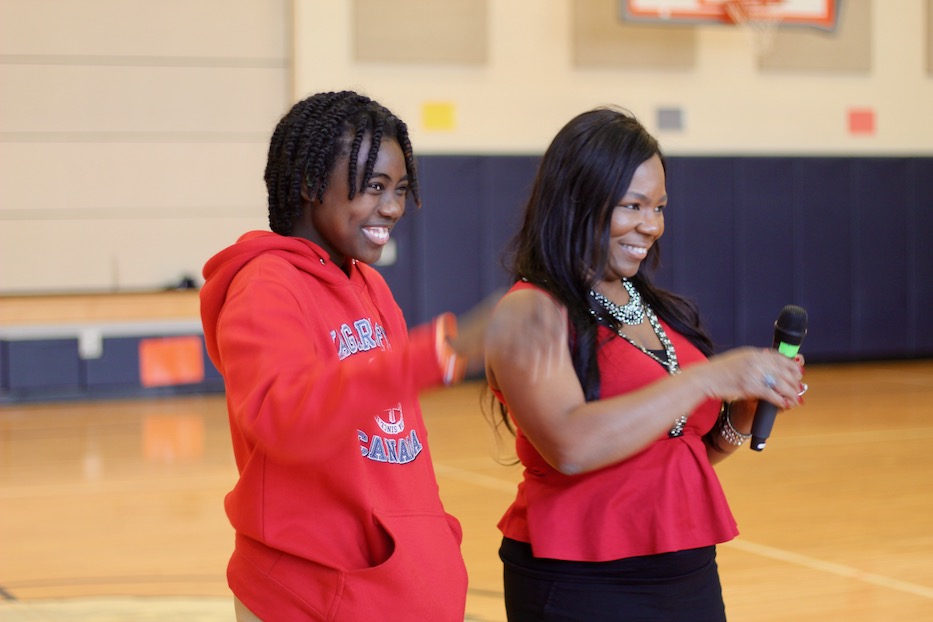
Culture & Community | Education & Youth | Alisa's House of Salsa | Arts & Culture | New Haven Schools | Hispanic Heritage Month | Mauro Sheridan Interdistrict Magnet School
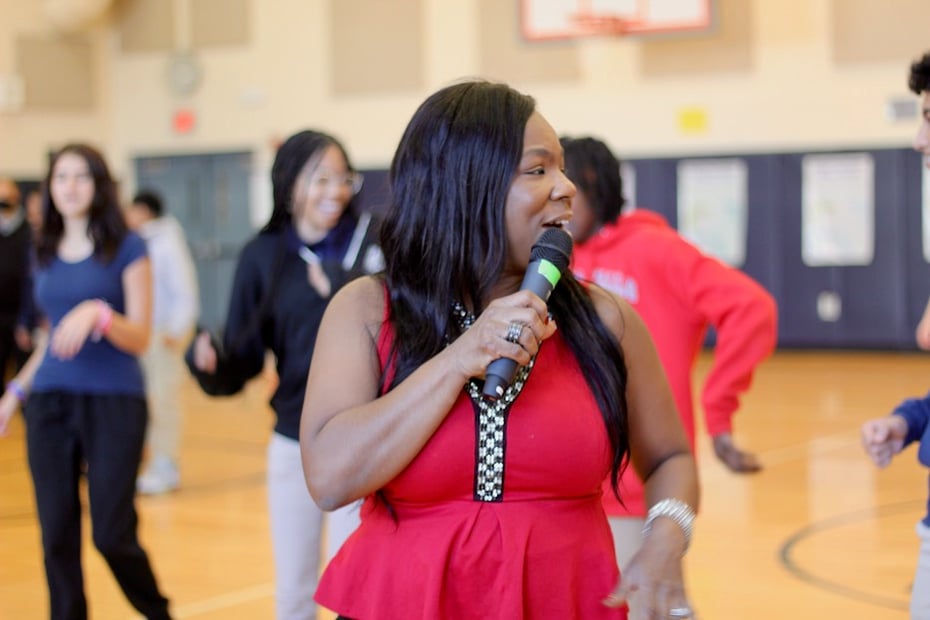
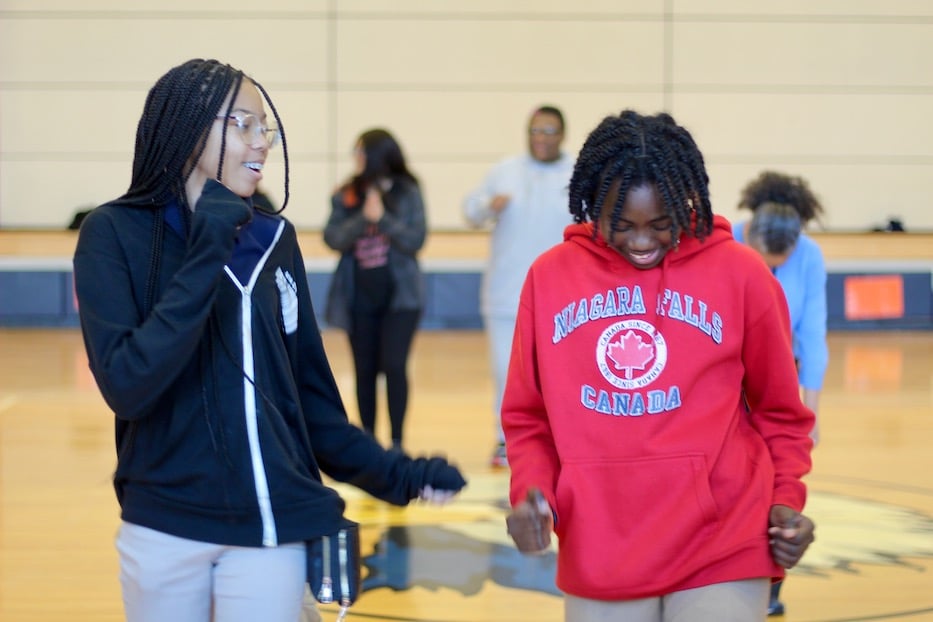
Top: Alisa Bowens-Mercado leads the class. Bottom: Keara Douglas and Harmoni Thomas. Lucy Gellman Photos.
Harmoni Thomas was all in. As the first sizzling keys of “Vivir Mi Vida” exploded over the gymnasium, her feet led the way, moving back and forth with a cha-cha-cha slipped between each step. Beside her, salsera Alisa Bowens-Mercado added a shimmy that the whole class could do. Harmoni rolled her shoulders forward and laughed.
“Alright everyone, say Wepa!” Bowens-Mercado said, her voice soaring. A cry of “Wepa!” rose across the floor, and for a moment it seemed as if even the building was dancing.
Harmoni is an eighth grader at Mauro-Sheridan Interdistrict Magnet School, a K-8 school that rises from Fountain Street in New Haven’s Westville neighborhood. Bowens-Mercado is a teaching artist in the same neighborhood, where she owns Alisa’s House of Salsa on Whalley Avenue. Tuesday afternoon, both helped the school dance out Hispanic Heritage Month with an hour of movement that had the entire room on its feet. By the end of the class, it had become a lesson in not just dance history, but also social and emotional learning.
“It’s about learning, it’s about doing something different, it’s about doing something outside of the box,” Bowens-Mercado told students as she began to move her arms with the beat, her elbows and shoulders unlocking in time with the music. “Take this opportunity today to learn something different.”
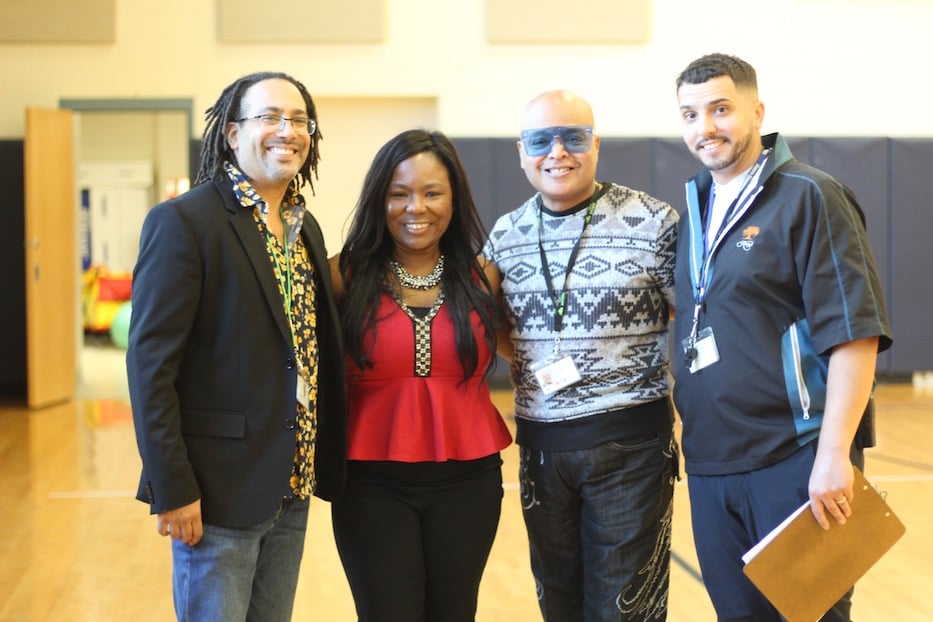
Jason Cartwright, Alisa Bowens-Mercado, Sean Hardy, and Marco Marques. Lucy Gellman Photo.
While Hispanic Heritage Month technically runs from September 15 to October 15, nobody seemed to mind Tuesday. Around Bowens-Mercado, eighth graders fanned out, listening as a playlist started with the first notes of Tito Puente’s “Oye Como Va” and then jumped back to Marc Anthony. On one side of the gym, Bowens-Mercado pulled Harmoni and Emmanuel Roman Jr. to the front of the group, beaming as they tried out a few first steps with the music.
The two looked down at their feet and then back up to the bleachers, where a few reluctant classmates still sat watching. Behind them, the gym became a sea of moving feet, heels and toes tapping as friends cheered each other on. For the next 50 minutes, Bowens-Mercado announced, they would be Harmonita and Emmanuelito, transformed by the movement alone. Anyone could transform through dance, she added: it was the fastest way to travel around the globe without ever leaving New Haven.
“I see some naturals!” she said, a mic in one hand as the other stretched out in front of her. To hurrahs and cheers of Yeaahhhh! from their classmates, Harmonita and Emmannuelito sped up their footwork, suddenly gliding over the floor. Harmonita threw a little swerve and shoulder action into the mix, and Emmanuelito burst into a smile, leaning forward as a fit of laughter caught him. Behind them, dozens of classmates followed their lead, arms pumping as the song hit an earwormy hook.
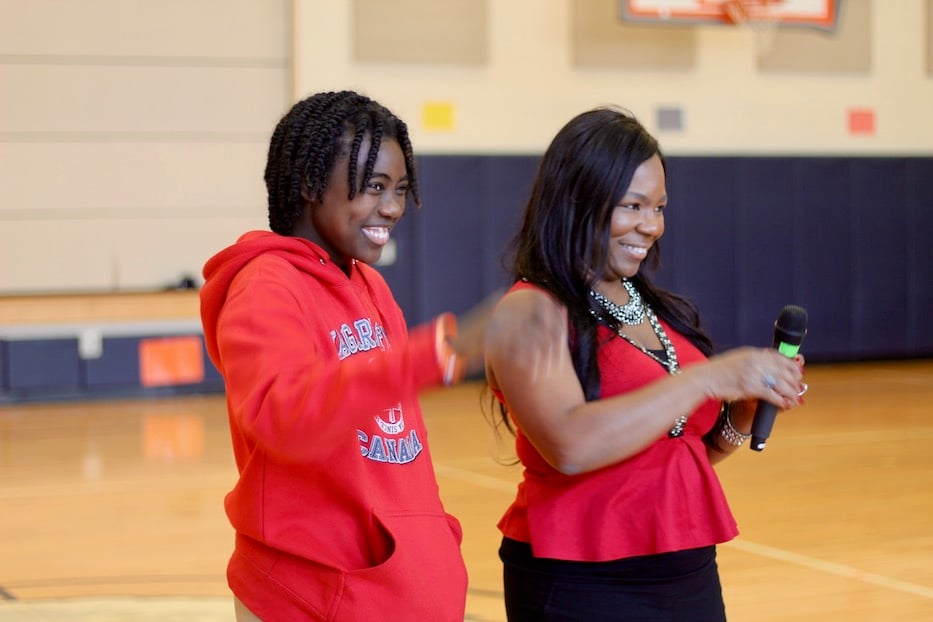
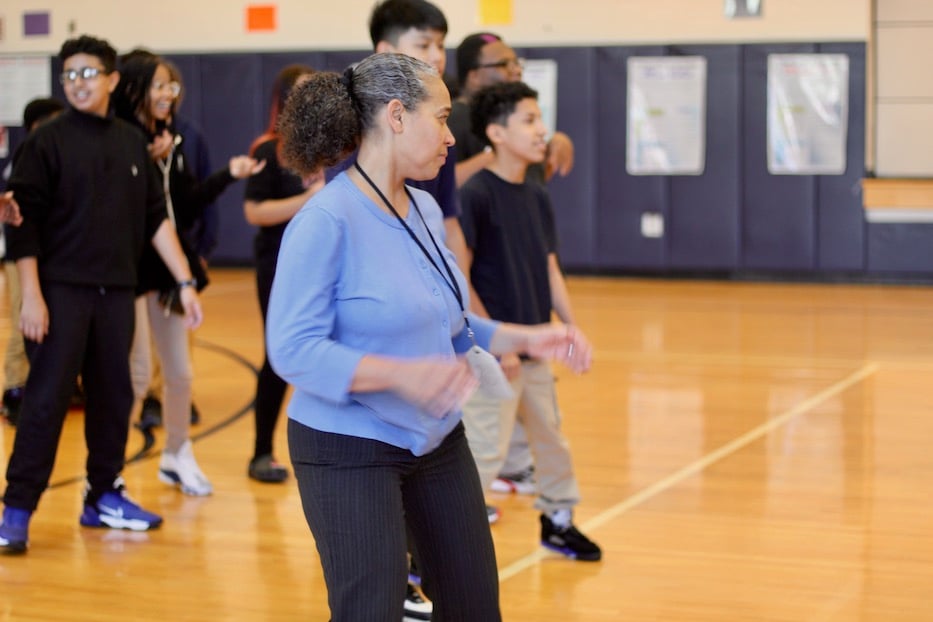
Top: Harmoni Thomas and Bowens-Mercado . Bottom: General music teacher Elisangela Ortiz sounds off in Spanish as students follow. Lucy Gellman Photos.
Voy a reír, voy a bailar! Vivir mi vida, la la la la! Anthony declared from a speaker. Giggles mingled with the squeak of sneakers on the gym’s smooth floor.
“Just do your best, and forget the rest,” chimed in physical education instructor Jason Cartwright, who students often refer to as “Coach C.” Earlier this year, Cartwright became a student at Alisa’s House of Salsa himself, where he now dances several nights a week.
They appeared to take the advice to heart. On the left side of the room, Demealio Black let the steps transport him halfway across an ocean, to the birth of salsa in Cuba and its precipitous spread across the Caribbean, South and Central America, Europe and the United States.
Born in Jamaica and raised between Connecticut and New York, Demealio said he sees arts as a window to both social and cultural history—and was excited to be trying something new.
“If I were to travel, it would be cool to learn, like, culture, and like dances and food and stuff,” he said, resting for a moment before rejoining the group to learn merengue. “There’s a lot of stuff you can get to know about through culture.”
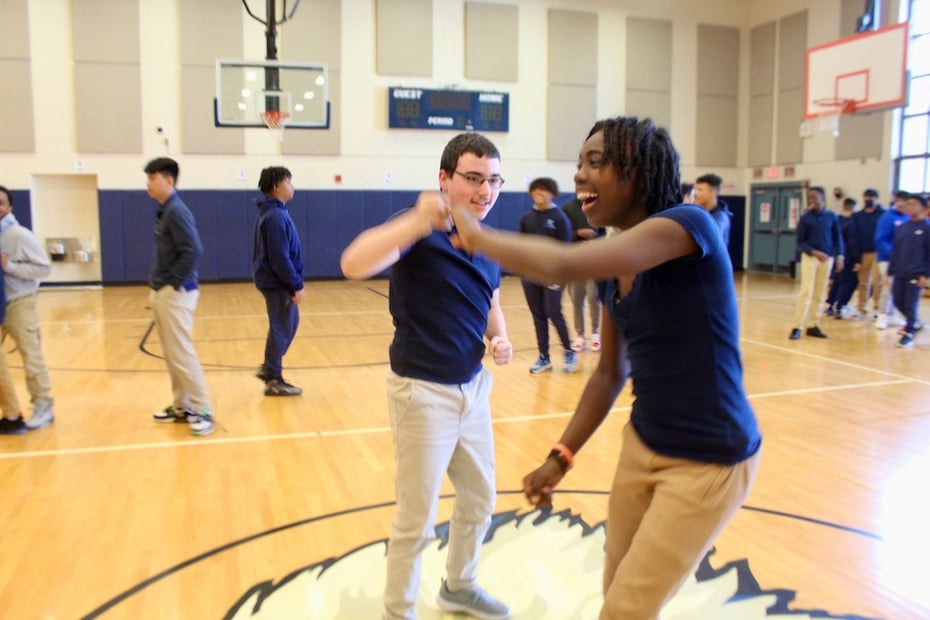
Harmoni Thomas: “It’s kind of like a way for getting out all of the troubles I’ve been going through,” she said of the class.
Back on the floor, students rocked a salsa one-two step, arms pumping as their hips swayed, and they tapped their toes gingerly behind their ankles. “We’re gonna side step!” Bowens-Mercado announced, and began to move to the side. “Yes! Right! Left! Right! Left! Everybody say cumbia!”
The support students had for each other became an invisible dance partner, always there in the room to extend a hand. When Bowens-Mercado paired students up midway through the session, her instructions became almost inaudible over the delighted shrieks of three dozen 12- and 13-year-olds, joining hands and twirling through the space one by one. The sound crested and fell over the room, traveling up to the rafters before it came back down.
Switching the track to Elvis Crespo’s “Suavemente,” Bowens-Mercado demoed a merengue slide, bringing Cartwright to the floor before turning it back to students. “We’re gonna walk in place, walk in place—” she started, looking around as the floor filled with movement. “Okay! You’re gonna count to five in Spanish!”
Weaving through a knot of students, general music teacher Elisangela Ortiz clapped in time with the music, and slid into a Spanish count-off that had voices rising. Uno! Dos! Tres! Cuatro! Cinco! she called out with Bowens-Mercado, and students raised their voices to match hers. Her low ponytail bounced to the music as Crespo crooned from the loudspeaker.
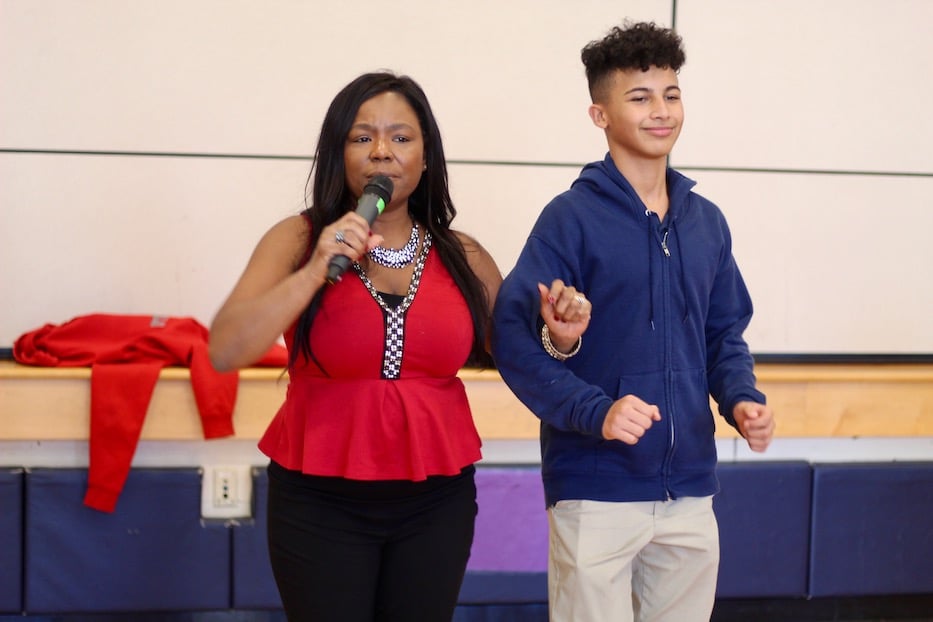
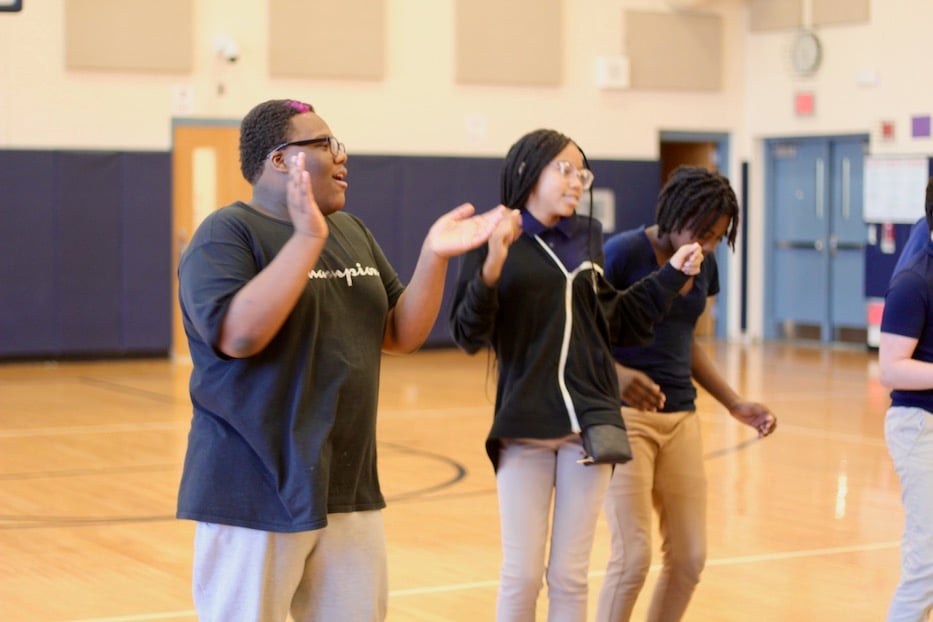
Top: Bowens-Mercado and Emmanuel Roman, Jr. Bottom: Semaj Battle-Reed (at far left). “I feel like it’s better to learn about more cultures in the world cause you can understand what they’re going through and how they went through it,” he said.
For many of the students, it became a form of unexpected emotional release and relationship building, in lockstep with a social and emotional learning (SEL) framework that the New Haven Public Schools have been working to implement for years now. SEL revolves around five competencies, including self-awareness, self-management, social awareness, relationship skills, and responsible decision-making.
All of those fold into dance, Bowens-Mercado noted—sometimes in a language of head nods, bright, wide and locking eyes, raised arms and clasped palms. For Harmoni, who jumped from salsa to merengue to a student dance-off from which she emerged victorious, the steady movement became an instant form of stress relief.
“It’s kind of like a way for getting out all of the troubles I’ve been going through,” she said. Sometimes, she gets overwhelmed by homework, schoolwork, her five siblings and chores at home. “And it gives me a chance to do dances from around the world. I was having fun.”
It opened a door to a culture she wouldn’t otherwise know about, she added. At home, Harmoni’s mom is Trinidadian, and her dad is Portuguese. Their house is constantly filled with music, she said—including the sound of her singing, and reggae that she loves to listen to. After dancing salsa for the first time on Tuesday, she said, she definitely could see returning to it. She added that she is trying to fluently learn Spanish, she said, but switched into French class after the school’s Spanish teacher left.
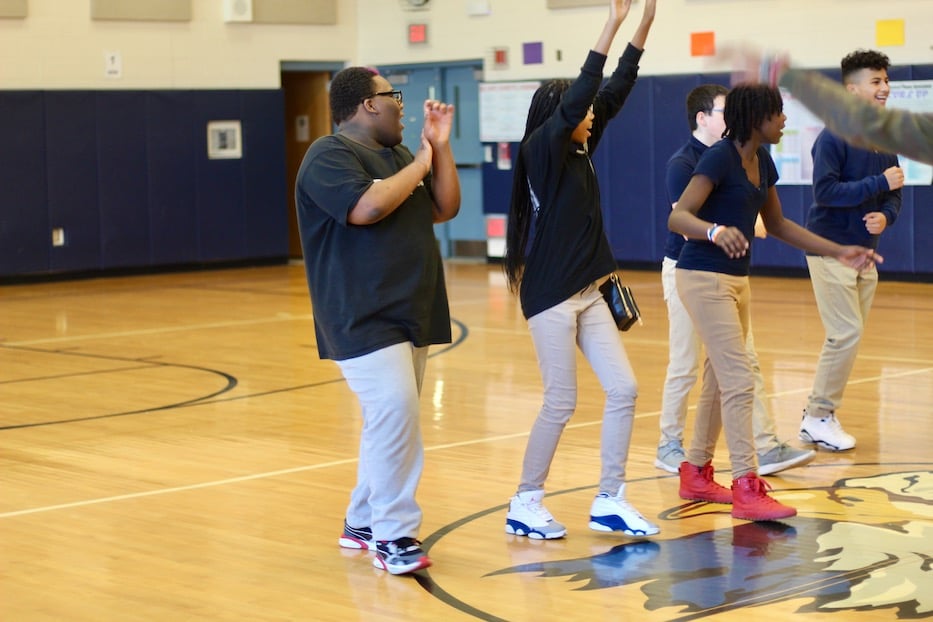
As he made his way toward the center of the gym, Semaj Battle-Reed struck a pose, a shock of bright pink running through his hair. He stepped one foot forward, raising his arms into the air, and then bringing them down to touch at the wrists. In an interview after the class, he praised Bowens-Mercado for showing him not just “how to move your body a little more,” but teaching him about other cultures with hands-on learning.
“I feel like it’s better to learn about more cultures in the world cause you can understand what they’re going through and how they went through it,” he said. “I think it’s a good thing. When you talk about your culture, it makes you feel good, because you know, like, where you came from.”
That’s part of the hope for this school year, said Instructional Assistant and Diversity Coordinator Sean Hardy. After meeting Bowens-Mercado years ago through the late Manny Rivera, he was thrilled to have her teaching at the school. Bowens-Mercado shared that excitement, she said: Of 38 events she has run across the state for Hispanic Heritage, this one was “in my own backyard.”
By the end of a 50-minute lesson, students were pulling off the moves as if they had danced for days. Bowens-Mercado encouraged them to take what they had learned back into their classrooms and homes when they left the gym.
“Sometimes, new and uncomfortable situations can turn into wonderful experiences,” she said.
Learn more about Hispanic Heritage Month here.

